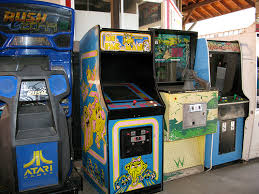

Early games used interactive electronic devices with various display formats. The earliest example is from 1947—a "Cathode ray tube Amusement Device" was filed for a patent on January 25, 1947 by Thomas T. Goldsmith Jr. and Estle Ray Mann, and issued on December 14, 1948 as U.S. Patent 2455992
Inspired by radar display tech, it consisted of an analog device that allowed a user to control a vector-drawn dot on the screen to simulate a missile being fired at targets, which were drawings fixed to the screen
Other early examples include:
* The NIMROD computer at the 1951 Festival of Britain
* OXO a tic-tac-toe Computer game by Alexander S. Douglas for the EDSAC in 1952
* Tennis for Two, an interactive game engineered by William Higinbotham in 1958
* Spacewar!, written by MIT students Martin Graetz, Steve Russell, and Wayne Wiitanen's on a DEC PDP-1 computer in 1961.
Each game used different means of display: NIMROD used a panel of lights to play the game of Nim,[5] OXO used a graphical display to play tic-tac-toe Tennis for Two used an oscilloscope to display a side view of a tennis court, and Spacewar! used the DEC PDP-1's vector display to have two spaceships battle each other.
In 1971, Computer Space, created by Nolan Bushnell and Ted Dabney, was the first commercially sold, coin-operated video game. It used a black-and-white television for its display, and the computer system was made of 74 series TTL chips. The game was featured in the 1973 science fiction film Soylent Green. Computer Space was followed in 1972 by the Magnavox Odyssey, the first home console. Modeled after a late 1960s prototype console developed by Ralph H. Baer called the "Brown Box", it also used a standard television. These were followed by two versions of Atari's Pong; an arcade version in 1972 and a home version in 1975. The commercial success of Pong led numerous other companies to develop Pong clones and their own systems, spawning the video game industry.
Source: Wikipedia






